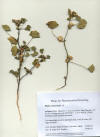Malva neglecta |
Malva parviflora Bractlets linear, calyx enlarged, petals relatively small. Leaves generally larger than what is described for the species
|
|
Huang C. Y., L. F. Zeng, T. He, C. J. Wang, J. R. Hong, X. Q. Zhang, Y. H. Hou and S. S. Peng. 1998. In vivo and in vitro studies on the antitumor activities of MCP (Malva crispa L. Powder). Biomed. Environ. Sci. 11(4): 297–306. “Four short-term in vivo and in vitro tests were used to further confirm the antitumor activities of MCP, a vegetable powder, prepared from Malva crispa L. (i) In the H22 hepatoma-transplanting test, MCP had antitumor action, but MCP residue did not show such action; 5-FU appeared to have more potent antitumor activities and more harmful effects than MCP. (ii) In the micronucleus (MN) test, MCP significantly decreased MN frequency. (iii) In the cancer cell culture systems, the MCP fat-soluble extract revealed inhibitory effects on the growth and proliferation of the human hepatoma and the gastric cancer cells in a dose-response manner. (iv) In the colony formation test, MCP also altered the morphology of human gastric cancer cells. It was suggested that MCP could be consumed not only by healthy subjects for cancer prevention but also by patients with cancer as supplementary treatment in combination with anticarcinogenic drug such as 5-FU, cyclophosphamide (CP). Shale T.L., W. A. Stirk and J. van Staden. 2005. Variation in antibacterial and anti-inflammatory activity of different growth forms of Malva parviflora and evidence for synergism of the anti-inflammatory compounds.J Ethnopharmacol. 2005 Jan 4;96(1-2):325-30. “Malva parviflora leaves and roots were collected from five sites within the Qacha's Nek District in Lesotho. These plants had two distinct growth forms--upright and prostrate. Hexane, methanol and water extracts were made from the plant material and tested for antibacterial and anti-inflammatory activity using the disc diffusion and cyclooxygenase-1 (Cox-1) bioassays, respectively. Hexane, methanol and water extracts made from Malva parviflora with a prostrate growth form inhibited the growth of Gram-positive and Gram-negative bacteria, while extracts made from plants with an upright growth form inhibited the growth of Gram-positive bacteria only. Cox-1 anti-inflammatory activity of hexane, methanol and water extracts did not show any variation between the two growth forms. The hexane extracts of both the leaves and roots were the most inhibitory. The water extracts had the least inhibitory activity. Bioassay-guided fractionation of the root dichloromethane extract showed that Cox-1 anti-inflammatory activity was caused by at least two compounds that acted synergistically to produce the biological effect.”
|
|



